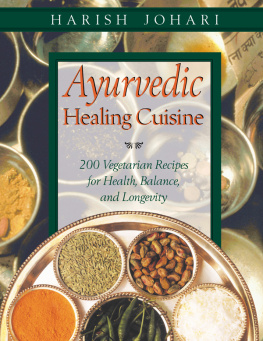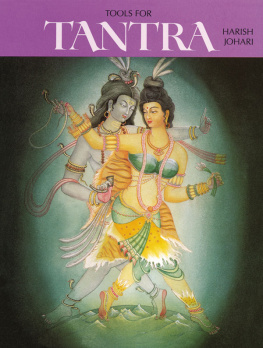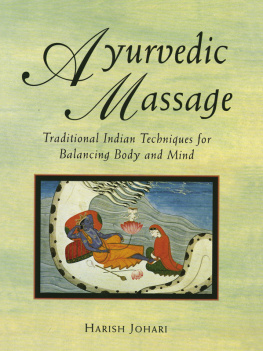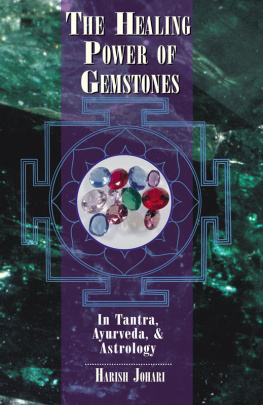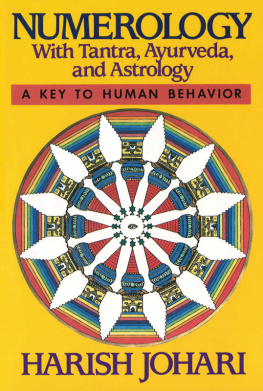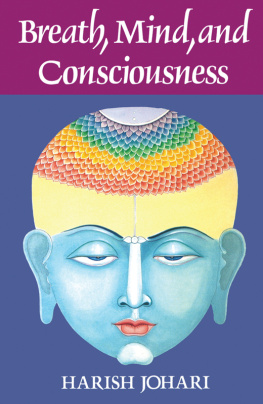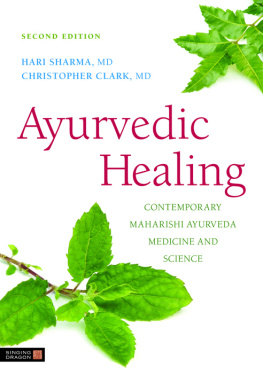Ayurvedic
Healing Cuisine

200 Vegetarian Recipes
for Health, Balance,
and Longevity
Harish Johari

Healing Arts Press
Rochester, Vermont
EDITORS NOTE
The first manuscript to come to Inner Traditions (Healing Arts Press) from Harish Johari was The Healing Cuisine. It was a massive five hundred pages, painstakingly handwritten and containing a wealth of Ayurvedic cooking knowledge and recipes heretofore unavailable in the West. That was more than ten years ago. In the interim, we have published six other titles by Harish (and three audiocassettes). Why did it take us so long to publish this title, especially as we received frequent calls and letters from Harishs friends from all over this country and abroad in search of the finished book?
To watch Harish preparing a mealwhether for four or for twenty-fouris to watch a master at work. Completely attentive to the task at hand, he cooks with every one of his senses. His hands, seemingly under invisible, inaudible instruction, simply know what to do. People are inevitably drawn into the kitchen to watch or to participate. There is always learning going on (Harish is, after all, a teacher of the first order) and a good bit of laughter. If you are willing, he will put you to work chopping vegetables or making chapatis. And while nothing overtly extraordinary is happening, a good deal of time goes by, a great deal of knowledge is passed along, and the result is always the sharing of an extraordinary meal.
It is hard to translate this experience into print. All the recipes were written in a manner consistent with Harishs cooking stylecharming, intuitive, and intelligible only if you were lucky enough to be at his elbow. The manuscript was put on hold for a couple of years while we mustered our courage. Finally, Harish and our editors set about the long process of translating the original text into a language and format that could be used by any cook in his or her Western kitchen (with the addition of some ingredients and implements that are described in the book).
The tradition of apprenticeship has, sadly, fallen away in many of our endeavors, but it is very much alive in the pages of this book. May the learning and laughter of that tradition be mixed in equal measure with the healing principles of Ayurvedic cooking.
Leslie Colket Blair
INTRODUCTION
Health is the state of harmonious chemical balance in a living organism. Our health depends on the chemical environments inside and outside our bodies. Food plays an important role in creating the internal chemical environment. Cooking food makes it palatable, digestible, and assimilable.
When cooked properly, food is appetizing, flavorful, and aromatic. Cooking is a way of offering love. Food that is cooked with love, guided by knowledge of the ingredients being cooked, and served in an inspiring atmosphere becomes healing. Food is something very personal and it should never be eaten for taste alone; its purpose is to provide nutrients and satisfaction to the body, without introducing toxins. This satisfaction comes from a state of electrochemical balance inside the organism, which is created by the postdigestive action of the food. A major part of chemical imbalance is created by living with incorrect habits and in a bad environment. This situation can be counteracted by eating good, healthful food.
Vegetarian food cooked with healing herbs and energizing spices can eliminate many of the toxins that have entered the body through polluted water and air, or even noise. Toxins also enter us through radiation or chemicals that are supposed to prevent our food from decay and that are used freely on vegetables, fruits, and all types of edible foodstuffs. Spicesconcentrated chemicals that are converted into cleansing and vitalizing frequencies by our electrochemical systemsave our body from chemical imbalance.
Cooking therefore is an art and a science at the same time. It is an art when the cook is inspired and completely absorbed in inventing a new dish, a new taste. When the cook, like a medicine man, uses herbs and spices to enhance the nutritional value, cooking is a science. But when the art and science of cooking combine in a cook, cooking becomes alchemy and food becomes Tantra. The love of the cook rejuvenates each and every cell of the body and food becomes an elixir, a tonic, a vitalizer, and a medicine.
A good cook knows that taste is a key to the chemical nature of food and that through taste he or she can manipulate the chemical environment of the body. There are six tastes and six kinds of taste buds; good food satisfies all the taste buds. A cook who knows the Ayurvedic principles of tastefor example, that the sweet taste is a combination of water and earth elements and it subdues Vata (Wind) and Pitta (Bile) and stimulates Kapha (Mucus)can play with these tastes and subdue the aggravated humor to reestablish the chemical balance.
Cooking is a way of caring that gives complete satisfaction. Indian cooks derive their knowledge of herbs and spices, vegetables, legumes, and so forth from Ayurveda, which helps them maintain physical, mental, social, and spiritual harmony.
A good cook should remember that alkaline body chemistry is an important key to good health and a long life. All foods should create such a balance that the body chemistry is predominantly alkaline. With age, body chemistry becomes more acidic and the wear-and-tear mechanism becomes more powerful. If older people introduce alkaline foods or foods whose postdigestive action is alkaline into their diets, they can remain healthy and live long lives.
The philosophy, cooking methods, and recipes in this book are based on Ayurveda, the most ancient system of Indian medicine. Ayurveda studies the physical and psychic behavior of people and prescribes ways for them to synchronize with their environment so as to live happy, healthy, and inspired lives.
Much emphasis is given to diet, following the cycles of the seasons, getting up before dawn, massage, and other useful practices for enriching life.
Information dealing with diseases, their diagnosis, and cures also exists within Ayurveda. It even encompasses surgery and plastic surgery. The term Ayurveda comes from ayu meaning life and veda meaning knowledge. The Greek system of medicine, which is parallel to Ayurveda, is called Unani-TibUnani meaning Greek and tib, medicine. These two medical systems understand and define the body in similar ways, and each incorporates the principles of doshas (humors), pulse, and diet. While it is hard to say whether they both stem from the same source, in India both Ayurveda and Unani-Tib are practiced.

Chapter One
PRINCIPLES OF AYURVEDA
THE FIVE ELEMENTS
All phenomenal existence is an interplay of different frequencies of vibrations, from the most subtle to the most dense. Ayurvedic seers and sages have classified these vibrations into a system of five elements. These elements are agents of the primary inertia principle of consciousness and belong to the material field. They are the materialized form of the universal energy, which exists as a continuum of frequencies.
Akasha, or ether, evolved first and is the most subtle of the five elements. From it comes air, from air evolves fire, from fire comes water, and from water comes earth. The human body, which is composed of these elements, is also nourished and maintained by them. They are responsible for all its psychophysical properties. In the body the five elements assume the form of the three doshas and work with the chemical nature of the organism. The three doshas are in fact the physiological counterparts of the five elements: Akasha and air combine to create the humor of Vata; air and fire combine to create the humor of Pitta; water and earth combine to produce the humor of Kapha.
Next page
